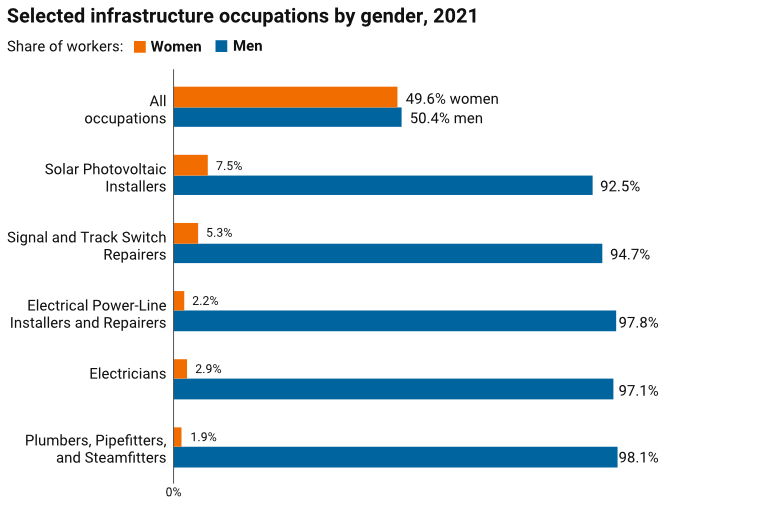
Seizing the U.S. infrastructure opportunity: Investing in current and future workers
Downloads
Investing in infrastructure can stimulate economic growth and unleash job creation nationally. Whether building roads, repairing pipes, or upgrading power plants, investments in the country’s transportation, water, energy, and broadband systems not only supports more economic output, but also drives the need for more workers. Several new pieces of federal legislation—including the Infrastructure Investment and Jobs Act (IIJA), Inflation Reduction Act (IRA), and the CHIPS and Science Act—are pumping hundreds of billions of dollars toward new projects and new jobs and are launching generational levels of investment not seen since the New Deal.
Leaders risk squandering this generational window of infrastructure investment if they only focus on future job creation without addressing the cracking foundation of the country’s current workforce.
State fact sheets
California
Colorado
Illinois
Massachusetts
Pennsylvania
Wisconsin
But national, state, and local leaders risk squandering this generational window of infrastructure investment if they only focus on future job creation without addressing the cracking foundation of the country’s current workforce.
Infrastructure investment already supports millions of workers nationally. Moving goods, producing energy, managing water, and carrying out many other essential activities depends on workers across every corner of the country and is foundational to economic growth and opportunity. Yet, hiring, training, and retention gaps remain vast across this workforce, as fewer workers are entering these careers and more workers are retiring and leaving these jobs than ever before. At the same time, too few of these job opportunities are filled by younger students, women, and people of color.
How can leaders expand the future infrastructure workforce if they cannot even hold onto the current infrastructure workforce? This report aims to equip leaders with more consistent data and information to better target, measure, and address their infrastructure workforce needs. It builds off past Brookings research to provide an updated look at current U.S. infrastructure employment, showing the hurdles faced by individual workers to fill these jobs and grow their careers.
Methods on defining and measuring the infrastructure workforce is available in a downloadable appendix. State fact sheets are also available here: California, Colorado, Illinois, Massachusetts, Pennsylvania, Wisconsin.
Navigating the Infrastructure Career Pipeline
While new federal funding offers enormous potential to grow more jobs, leaders face a massive challenge that has existed for some time: struggles to recruit and hold onto current infrastructure workers, which limits the country’s pool of talent to take on existing needs, let alone expand the pool of talent to take on new tasks. These gaps exist despite several long-term opportunities in the infrastructure sector, including multiple career pathways, competitive wages, and transferable skills.
95 infrastructure occupations employ 16.6 million workers nationally.
Young prospective workers face many potential pathways in the infrastructure sector, whether looking to become an electrician, plumber, or civil engineer and joining 16.6 million other workers nationally (11.8% of the country’s workforce). Most of these careers are involved in operating and maintaining roads, pipes, power lines, and other systems, rather than simply constructing them, leading to long-term job opportunities.
Infrastructure occupations pay 30% higher wages to lower-income workers.
They can also earn higher pay. Infrastructure occupations pay 30% higher wages to workers at lower income levels, supporting more equitable career pathways. In particular, they pay $31,750 and $39,270 at the 10th and 25th percentile, respectively, compared to $23,980 and $29,950 for all occupations at these percentiles. Large occupations paying higher wages range from bus and truck mechanics, to highway maintenance workers, to electrical power-line installers, and include many unionized positions. This means higher pay for workers just entering the labor market or transitioning into these positions for the first time, offering more opportunity to those grabbing the bottom rungs of the career ladder.

But prospective workers often do not even know these careers exist or consider them a career of choice. Students in high school (and earlier) may not enroll in classes geared toward these careers—including those in science, technology, engineering, and math (STEM) fields—and they may not have the mentorships or other connections and repeated opportunities to explore related careers. Meanwhile, infrastructure employers, including transportation departments and utilities, tend to overemphasize projects, struggle to reach out to these workers, and rely on inflexible, outdated HR practices to get them in the door.
Mid-career workers—including those who are unemployed or underemployed—face similar opportunities to enter or transition into these careers. And they can often do so without having to get an advanced degree. Most infrastructure workers (53.8%) have a high school diploma or less, which contrasts sharply with the shares for workers across all occupations nationally, 31.6% of whom have a high school diploma or less. Yet they still earn competitive wages, whether employed as wind turbine technicians, septic tank servicers, or rail car repairers.
53.8% of infrastructure workers have a high school diploma or less

Instead they develop skills and experience on the job; 86.8% of infrastructure workers need some level of on-the-job training, compared to 62.6% of workers across all occupations nationally. Infrastructure workers develop many specialized skills and earn specialized credentials through work-based learning, but they still rely on many similar types of knowledge that can be transferrable, such as knowledge in public safety and security, engineering and technology, law and government, and more.
Such extensive on-the-job training, though, can create barriers to entry and create hurdles to advance their careers. Workforce development approaches in infrastructure are often highly siloed and fragmented by the specific industry, employer, and geography; workers tend to gain degrees, licenses, and certifications for a particular job in a particular place—as an electrician or plumber, for instance—which can limit their ability to move or advance their careers across the country. Workers can also lack supportive services, such as childcare and transportation, making it even more difficult to gain a foothold in these careers.
Advanced workers, especially those already in the infrastructure sector, are essential to constructing, operating, and maintaining the county’s physical systems—and have done so while earning higher wages and developing valuable skillsets. However, many are either eligible for retirement or simply transitioning out of their roles altogether. From 2021 to 2031, projections show 1.7 million infrastructure workers (12.2%) leaving their jobs each year on average, leading to huge replacement needs. Moreover, these holes may be even bigger to fill than any projected job growth from new federal infrastructure funding, which estimate up to 1.5 million new jobs created annually over the next decade.
Projections show 1.7 million infrastructure workers leaving their jobs each year on average

Note: New jobs created are estimated based on new federal infrastructure spending, while the projected jobs that need to be filled are based on retirements and other labor force exits as well as transfers to other occupations.
For more on projected infrastructure job growth and worker shortages, see page 25 in the full report »
Only about 1 in 5 infrastructure workers are women, significantly lower than national averages
Many of these workers are frequently older, male, and white, signaling a need to reach more and different types of workers in coming years.Many infrastructure workers are 45 years and older, such as transit and intercity bus drivers (72.8%), power distributors and dispatchers (55.7%), and rail yard engineers (53.8%); perhaps even more concerning, though, are the 11% of workers 24 years or younger. In addition, women make up only 18.5% of all infrastructure workers, while they make up 49.6% of all workers nationally, and the shares of Black, Hispanic, and Asian workers can also be frequently lower than national averages across a range of occupations.

Hiring and training workers have posed difficulties for several decades, but simply holding onto infrastructure workers is becoming increasingly problematic. A “silver tsunami” of workers has swelled in recent years, causing many infrastructure employers to see 10% (or more) of their workers retire annually, and as more of these workers reach the end of their careers with fewer younger workers to pick up the baton, vast amounts of institutional knowledge and skills may be lost forever. But many other workers are also simply fed up, quitting their jobs in higher numbers to seek additional pay, workplace flexibility, and other benefits, similar to other “Great Resignation” issues affecting the economy.
A map to grow the future and current infrastructure workforce

